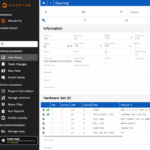A while back, I wrote an article for Doors & Hardware about panic hardware requirements for rooms housing electrical equipment. The rule of thumb is panic hardware is required if the room has equipment with more than 600 volts, or more than 800 amps (previously 1200 amps), or if it’s a battery room. This is based on the 2014 National Electrical Code – the International Building Code has slightly different requirements but we’re working on making the two consistent in the next editions.
Someone asked me recently how the voltage and amperage are determined. Do you add up the voltage or amperage of each piece of equipment and look at the total? Or is it the highest voltage/amperage of any piece of equipment that determines whether the room is over the threshold where panic hardware is required?
To be honest, I had never thought about this question specifically. I guess I assumed that it would be handled in a similar way as sizing a power supply – all of the loads are the same voltage, and you add the amperage of each load to find the total amperage. I was thinking about electrical rooms the same way…if someone had put me on the spot I would have looked at the maximum voltage to see if it was over 600 volts, and added the amperage of each panel to see if the total was over 800 amps.
I couldn’t find the answer in NFPA 70 – The National Electrical Code, so I asked NFPA and was told that you consider the piece of equipment with the maximum voltage and the piece of equipment with the maximum amperage. For example, a room with one piece of equipment rated at 800 volts would require panic hardware, but a room with 2 pieces of equipment rated at 480 volts each would not. A room with one piece of equipment rated at 1000 amps would require panic hardware, but a room with five 200-amp panels would not.
I’m not sure this is how all AHJs have been enforcing the panic hardware requirement. What’s your experience with this? Is there any place to find this in writing?
You need to login or register to bookmark/favorite this content.





The maximum amount of current (amps and voltage are inversely proportional- Ohm’s Law) could be easily determined by the size of the conductors entering the room. The simplest solution would be to set the threshold by the size of the wire coming from the grid into the room. In my opinion the threshold should be much lower than it currently is. Any room with over 100 amps @ 240 volts entering should be required to have panic hardware and be fire rated.
With a 100 amp, 240 volt panel, every new home would require panic devices. As far as I know, every new home has at least a 200 amp panel and the bigger the house the bigger the panel.
Interesting question — seems best to go back to code intent and ask the Electrical Code people for clarification, which is what you did. My understanding of code intent is that if an individual is injured while working on the equipment, that person has fast access out of that space, which would point to just the capacity of any one piece of equipment, not a summation of all the pieces; the worker is only working with one piece at a time. But then again, this question has not come up with any of my projects…
For what it’s worth, my brother-in-law was temporarily blinded by arc-flash while working on a piece of equipment — he was grateful for being able to get out of the room quickly and find help (he’s OK now).
Wow! I’m glad he’s ok!
I have had reverse a door and install panic hardware on a high current elevator electrical switch room for a local power utility company that was mandated by federal guides. Please someone here let me know any corrections to this.
Well, there are “Volts”, there are “Amps”, and there are “Watts”.
Both Volts and Amps stand on their own as to Words. As to Watts,
that is defined as a combination of Volts (times) Amps.
Example: 120 Volts (X)10 Amps equals 1200 Watts, or 1.2 KiloWatts.
12 Volts (X) 1000 mA equals 12 Watts
Hope this adds something of an answer to your question.
Highest potential amperage in a given space is determined by the rating of the service entrance disconnect overcurrent protection. This is the maximum amount of amps the contents of the room can draw, regardless of what the maximums draws of all the loads add up to.
Voltage is just the highest voltage service in the space.
If equipment with over-current or switching devices rated 1,200A or more is installed, personnel door(s) for entrance to and egress from the working space located less than 25 ft from the nearest edge of the working space must have the door(s) open in the direction of egress and be equipped with panic hardware or other devices that open under simple pressure. The working space is at a minimum 30” wide but must be at least the width of the largest panel. The measurement starts at the edge nearest the exit 25 feet away. The over-current rating in Amperes is usually printed visibly on the breaker or on a label on the equipment.
History has shown that electricians who suffer burns on their hands in electrical arc flash or arc blast events often can’t open doors equipped with knobs that must be turned. So experiences have taught us to use super easy panic hardware for these victims and they might not be able to see clearly either. I was temporarily blinded by an arc flash that destroyed a voltage meter I was holding in my hand. It took me about 30 seconds to see anything and what I found was only the very bottom of the meter case and nothing else. I was very fortunate.
An additional concern might be if the room contains a large enough transformer, maybe free standing or in a substation cabinet, the room might need to have a 1 hour fire rating. The unrated panic hardware should then be upgraded to fire rated hardware with the press bar typical of panic hardware. I am not sure how to properly write that.
Some electrical vaults might contain equipment with very high voltages, 35,000 volts or more, these have very special fire requirements.
Gerald is correct but it has changed I think
For some electrical rooms, the 2014 edition of NFPA 70 has removed the “simple pressure” terminology, and now requires “listed panic hardware.” Personnel doors within 25 feet of the working space and intended for entrance and egress are required to have panic hardware in the following conditions:
• Where equipment is 600 volts or less and 800 amps or more and contains overcurrent devices, switching devices, or control devices (110.26 (C) (3))
• Where equipment is 600 volts or more (110.33 (A) (3)
• Battery rooms (480.9 (E)
This is a direct quote and I hope we all understand the changes and it will effect a lot of the things we do when looking at or checking and to not forget – last – working on these doors.
Thanks Robert. The IBC still says 1200 amps but the 2014 NEC changed as you quoted in your comment. There’s more information in the linked article: http://idighardware.com/2013/09/decoded-panic-hardware-on-electrical-rooms/.
– Lori
Thanks Lori
the one question I hear a lot is that – Is the door on the Electrical room to be fire rated or is the hardware to be rated
This is a question I come across lots as we go from building to building as it is a lot of codes to keep track of and its not getting easier but it sure helps with your site and the forums on the codes. doing the FDAI is an interesting field to open.
The author Lori discusses volts. The consideration is 800 amps or greater in the Code and voltage is not considered. So, where does the author get volts? I need a reference paragraph to clarify his usage.
I would like a separate email to give me the answer
Hi Ed –
There is more information in this article, including the paragraphs from the National Electrical Code that reference rooms containing equipment with more than 600 volts: http://idighardware.com/2013/09/decoded-panic-hardware-on-electrical-rooms/. Feel free to email me if you have any questions. lori.greene@allegion.com
– Lori
I just ran into an inspector that considers the busway to be “equipment” and is requiring any room that has the busway running through it to also have panic doors. Arg. I can understand if the busway has a switch in that room, but not if it is just bypassing.